Physical Address
304 North Cardinal St.
Dorchester Center, MA 02124
Thoracic surgeons routinely rely on intraoperative consultations with frozen section to help determine the appropriate surgical procedure best indicated for a particular patient (Aijaz et al, 1993; Cohen and Flinner, 1960; Gal and Cagle, 2005; Gal, 2005; Sakai et al, 1994). The goals of intraoperative consultations during thoracic surgery vary according to the clinical problem, and it is important that pathologists and their surgical colleagues communicate effectively, develop a mutual understanding of what type of information is needed in particular situations, and become familiar with the strengths and limitations of the frozen section procedure. For example, in a patient being biopsied for the evaluation of interstitial lung disease, acute respiratory distress, or other nonneoplastic conditions, all the information needed by the thoracic surgeon intraoperatively is whether sufficient diagnostic tissue has been collected (Marchevsky, et al, 2004, Sienko et al, 2005). However, the pathologist needs to consider that he or she is responsible not only for providing immediate diagnostic information but also for ensuring that the tissues are triaged appropriately for routine histopathology, cultures, immunofluorescence, and other ancillary studies. In contrast, in a patient with a lung mass clinically presumed to be lung cancer, the thoracic surgeon needs to learn whether the frozen section is diagnostic of malignancy and whether certain malignancies that generally preclude further surgery such as small cell carcinoma, malignant lymphoma or others can be excluded (Marchevsky et al, 2004; Gupta et al, 2009; Gupta et al, 2008; Herbst et al, 2009; Walts and Marchevsky, 2012a).
Mediastinal adenopathy can be evaluated with noninvasive imaging procedures, such as computerized tomography (CT) scanning and positron emission tomography (PET), and with invasive techniques, including esophageal endoscopic ultrasound-guided (EUS) needle aspiration (EUS-NA), EUS transbronchial fine-needle aspiration (EBUS-TBNA), transthoracic needle aspiration (TTNA), video-assisted thoracotomy surgery (VATS) biopsy, mediastinoscopy, extended cervical mediastinoscopy, and the Chamberlain procedure (Detterbeck et al, 2007; Silvestri et al, 2007). The pooled sensitivity and specificity of CT scanning for the diagnosis of mediastinal lymph node metastasis is 51% and 85%, respectively (Silvestri et al, 2007). The pooled sensitivity and specificity of PET for identifying mediastinal metastasis is 74% and 85%, respectively (Silvestri et al, 2007). Mediastinoscopy is considered the gold standard for diagnosis, with tissue confirmation of mediastinal adenopathy with 100% specificity, but it does not allow access to all lymph node stations, resulting in an average sensitivity of 80% and a false negative rate of 10% (Detterbeck et al, 2007). Video mediastinoscopy appears to yield slightly better results with a sensitivity of 90% and a 7% false-negative rate (Detterbeck et al, 2007). A detailed description of the advantages and pitfalls of mediastinoscopy and other surgical sampling techniques, such as the Chamberlain procedure, is beyond the scope of this chapter.
Frozen sections of mediastinal lymph nodes are routinely performed on patients undergoing mediastinoscopy for staging of lung cancer, but this procedure is also performed periodically to evaluate lymph nodes from patients presenting solely with mediastinal adenopathy (Clarke et al, 1994; Ergene et al, 2012; Sanli et al, 2008). It is important that the surgical pathologist review the clinical chart or electronic medical records of each case and/or discuss the clinical history with the thoracic surgeon because the goals of the intraoperative consultation are different in these two situations ( Table 9-1 ).
| Patient has a lung mass |
|
| Patient has only mediastinal adenopathy without lung mass |
|
Patients with a lung mass on chest imaging studies suspicious for a non–small cell carcinoma (NSCLC) generally undergo VATS wedge biopsy of their pulmonary lesions if the lymph nodes are negative for metastatic carcinoma at mediastinoscopy. It is therefore important to evaluate with frozen section all lymph node materials received at the time of intraoperative consultation to minimize the possibility of a false-negative diagnosis of metastatic malignancy (Sanli et al, 2008).
The diagnosis of metastatic non–small cell carcinomas (NSCLC) to mediastinal lymph nodes is generally straightforward, and thoracic surgeons do not need a specific diagnosis of cell type in instances of poorly differentiated carcinomas ( Figure 9-1 ). However, this diagnosis can be difficult in cases when the quality of the frozen section is suboptimal and the lymph nodes have increased macrophages that exhibit prominent nucleoli, simulating a metastatic NSCLC ( Figure 9-2 ). Macrophages are usually smaller and less cohesive than carcinoma cells and lack nuclear features of malignancy such as macronucleoli, irregular nuclear membranes, and irregularly distributed chromatin. Macrophages also generally have more abundant cytoplasm than carcinoma cells, resulting in lower nucleocytoplasmic ratios (N:C), and their cytoplasm tends to be granular and sometimes focally pigmented ( Figure 9-2C, D ).
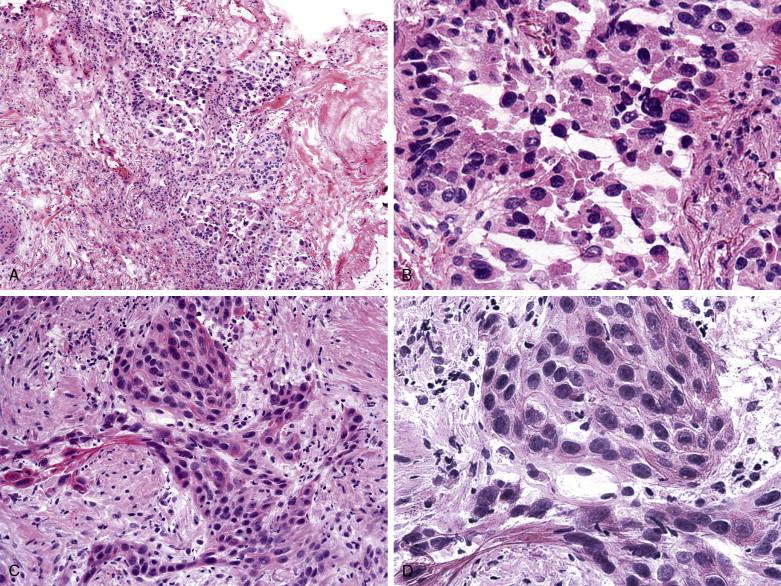
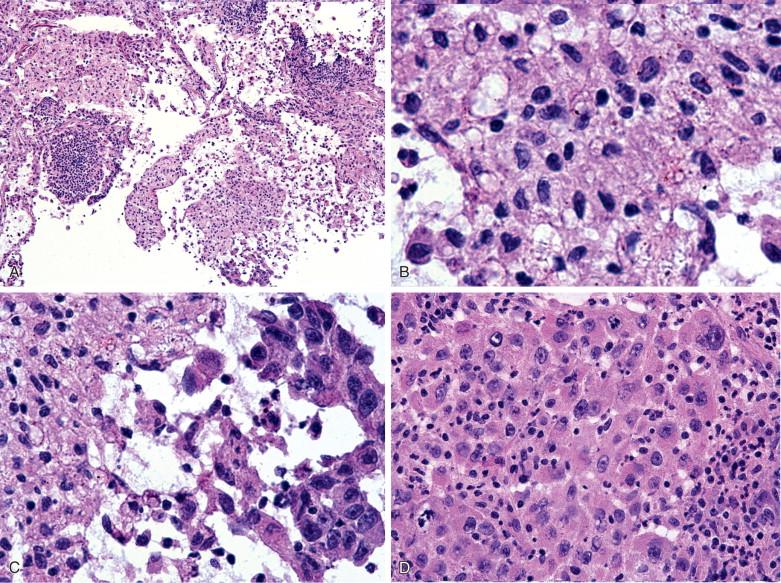
NSCLC also need to be distinguished from other neoplasms such as malignant lymphomas and small cell carcinoma; once these neoplasms are diagnosed at mediastinoscopy by frozen section, the thoracic surgeon is unlikely to explore the chest and perform a VATS wedge biopsy or resection of the lung lesion (Marchevsky et al, 2004; Gupta et al, 2009; Gupta et al, 2008; Herbst et al, 2009; Walts and Marchevsky, 2012a).
The differential diagnosis between NSCLC and typical or atypical carcinoid tumors is discussed later in this chapter. This distinction can be important in selected patients with carcinoid tumors that need to be treated with only sublobar resections, but because lobectomy is an acceptable treatment for primary pulmonary carcinoid tumors, failure to accurately distinguish these neoplasms from NSCLC intraoperatively has limited clinical consequences ( Figure 9-3 ) (Gupta et al, 2009).
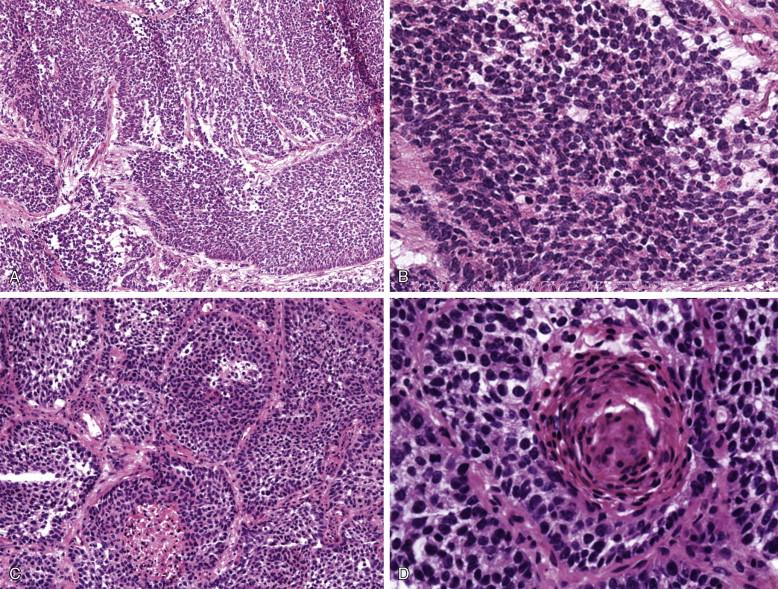
The frozen section diagnosis of small cell carcinoma can be difficult because “crushed” benign lymphoid cells can resemble tumor cells, particularly in frozen sections of suboptimal quality ( Figure 9-4A, B ). The surgical pathologist needs to find well-preserved areas showing tumor cells that are two to three times larger than normal lymphocytes, with hyperchromatic nuclei showing a “salt-and-pepper” chromatin pattern ( Figure 9-4C, D ). Imprint cytology with touch preparations can be particularly helpful for this diagnosis ( Figure 9-5 ) (Clarke et al, 1994; Orki et al, 2006).
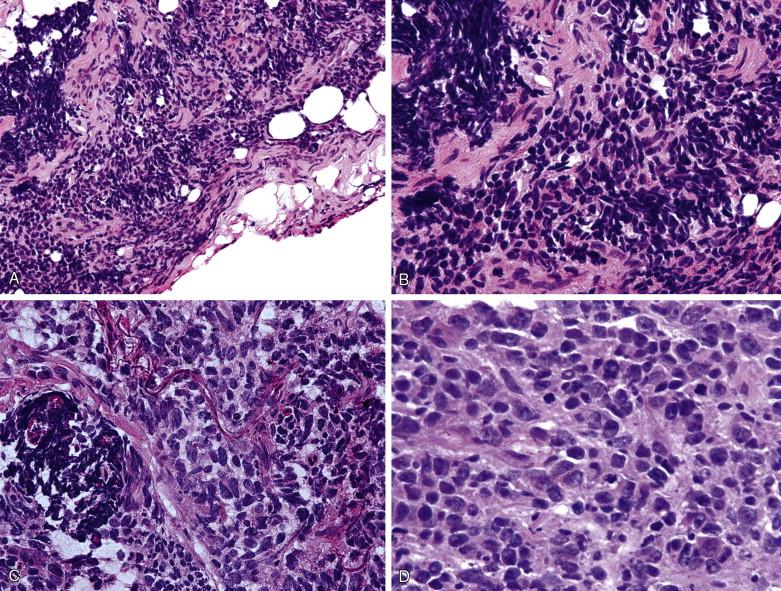
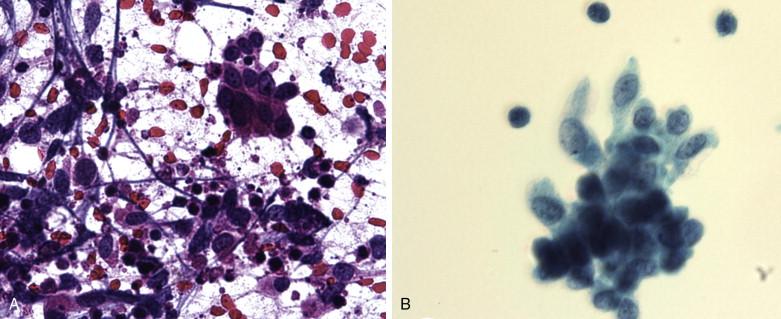
Low-grade lymphomas can be difficult to distinguish from benign lymph nodes but are unlikely to be mistaken for other lesions. In contrast, large cell lymphomas can be very difficult to distinguish from NSCLC on frozen sections of mediastinal lymph nodes, particularly in patients with mediastinal adenopathy and a lung mass. In general, the cells of large cell lymphoma are more discohesive than those seen in carcinomas and show scanty cytoplasm and large nuclei with irregular nuclear membranes, prominent nucleoli, and a granular chromatin pattern ( Figure 9-6A, B ). Touch preparations can be particularly useful to identify these cytologic features ( Figure 9-6C, D ).
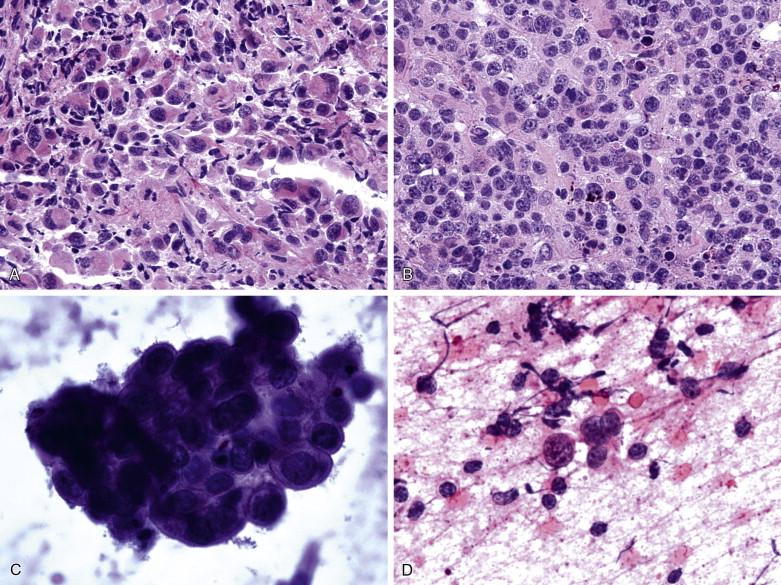
In contrast with the previous situation, although the lymph nodes of patients with mediastinal adenopathy that lack a visible mass on chest imaging may still have metastatic carcinoma (e.g., occult lung cancer, breast carcinoma, renal cell carcinoma, and melanoma) ( Figure 9-7 ), the differential diagnosis in this situation is broader and includes various other conditions, such as sarcoidosis, infectious granulomatous lymphadenitis, silicosis and malignant lymphoma ( Figure 9-8A-D ) (Marchevsky et al, 2004; Gupta et al, 2009; Nashef et al, 1993). Because a diagnosis of these various conditions usually requires cultures, histochemistry, immunohistochemistry, flow cytometry, and/or molecular studies, pathologists should not use the entire lymph node materials obtained by mediastinoscopy for frozen section; they should preserve some fresh tissue materials for these ancillary studies.
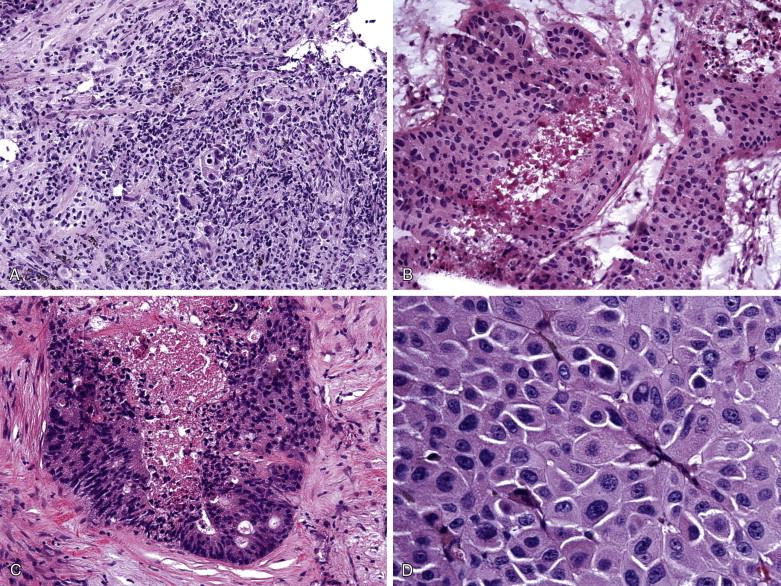
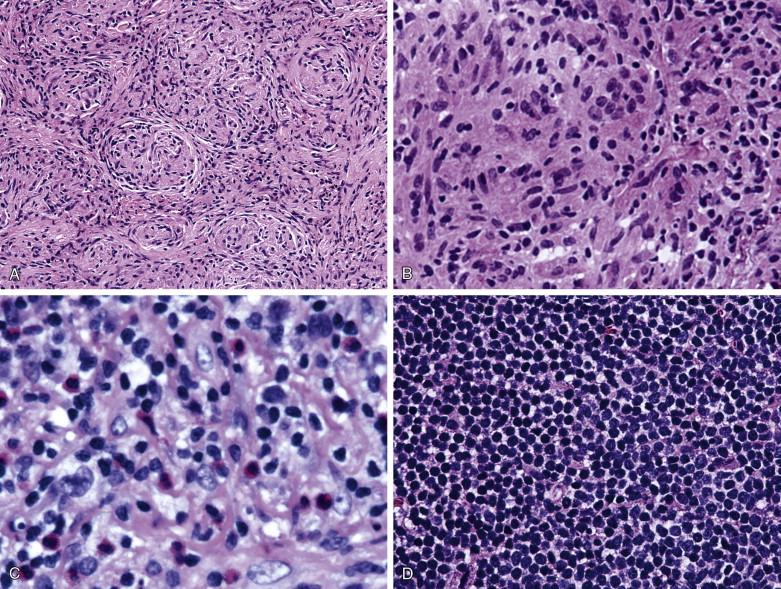
Granulomatous lymphadenitis and large cell lymphoma can usually be readily diagnosed on frozen section, but well-differentiated lymphocytic lymphomas, Hodgkin lymphoma, and other lymphoid malignancies can be difficult to recognize intraoperatively. As discussed before, the cells of large cell lymphomas are generally less cohesive than NSCLC and have large nuclei with coarse chromatin and irregular nuclear membranes and variable amounts of cytoplasm that can be basophilic in immunoblastic lymphomas ( Figure 9-6A, B ). Imprint cytology is particularly helpful for the diagnosis of malignant lymphomas in mediastinal lymph nodes to recognize the generally discohesive tumor cells and to recognize in more detail their nuclear details and contrast them with malignant epithelial cells that tend to form small groups composed of large cells with prominent nucleoli and more abundant cytoplasm that can be vacuolated in adenocarcinomas ( Figure 9-6C, D ) (Clarke et al, 1994; Orki et al, 2006).
Frozen section is generally considered to be very accurate for the diagnosis of metastatic neoplasms to mediastinal lymph nodes, although a literature review shows no clear information about the actual accuracy of frozen section for the diagnosis of metastatic NSCLC. Most studies evaluating the diagnostic accuracy of mediastinoscopy have not specified whether they report actual intraoperative and frozen section or final diagnoses accuracy. For example, a recent study of 136 bronchogenic carcinoma patients undergoing mediastinoscopy reported sensitivity, specificity, positive-predictive, and negative-predictive values of 94.5%, 100%, 100%, and 90%, respectively for the frozen section procedure, but it is difficult to assess if these results were obtained using only the frozen section slides or permanent sections (Sanli et al, 2008). Quality assurance data from our busy pathology practice show frozen section error rates lower than 1%, with occasional false-positive diagnoses of malignancy in cases where macrophages with reactive changes were overdiagnosed as metastatic malignant cells ( Figure 9-2 ) and a small number of false-negative cases where tumor cells were either overlooked during the rush of performing multiple frozen sections or not sampled intraoperatively. False-negative cases resulting from sampling problems and where the tumor is identified the day after the intraoperative consultation on deeper permanent sections are particularly frustrating. They raise questions regarding how many slides should be prepared from mediastinal lymph nodes at the time of intraoperative consultation and whether the entire tissue block should be “exhausted” during the intraoperative consultation. In our opinion, it is important to trim the tissues so that the sections are representative of the entire sample and not to just cut the superficial portion of the frozen tissues ( Figure 9-9 ). It is our current practice to prepare two or three slides, taken from the initial and the deep portions of the frozen tissue, and not to “exhaust” the entire tissues at the time of frozen section, in case tissue is needed for immunohistochemistry, fluorescent in situ hybridization (FISH), and/or molecular studies.
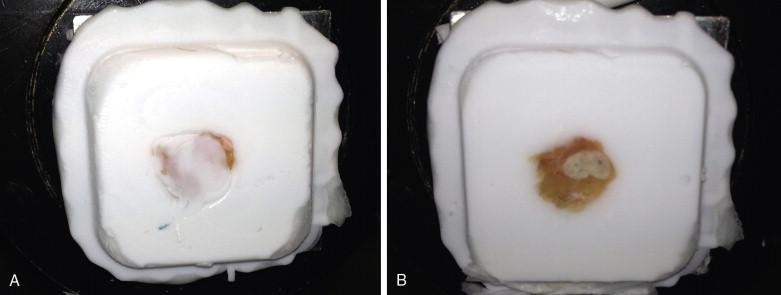
Endobronchial ultrasound-guided transbronchial needle aspiration (EBUS-TBNA) is a novel diagnostic method by which mediastinal, hilar, and intrapulmonary lymph nodes can be aspirated under real-time ultrasound control from the trachea or main bronchi (Ye et al, 2011). EBUS-TBNA can be performed in an operating room or an ambulatory setting and yields only slightly lower sensitivity and specificity than mediastinoscopy for the staging of NSCLC patients (Agarwal et al, 2012; Annema and Rabe, 2006; Hermes, 2012). For example, a recent study of 101 patients by Ye and associates reported that EBUS-TBNA yielded sensitivity, specificity, positive-predictive, and negative-predictive values of 95.1%, 100%, 100%, and 93%, respectively (Ye et al, 2011). Adequate sampling by EBUS-TBNA of mediastinal, hilar, and intrapulmonary lymph nodes can be difficult because some metastatic lesions are associated with extensive necrosis, stromal sclerosis, or cystic changes, resulting in paucicellular yield. The cytological appearance of metastatic NSCLC in specimens obtained by EBUS-TBNA is variable and depends on the cell type, the degree of differentiation, and the origin of the malignancy. In general, carcinoma cells tend to form cohesive flat or three-dimensional cellular clusters and exhibit cytologic features of malignancy such as variable anisocytosis, high N:C ratio, nuclear hyperchromasia, prominent nucleoli, and/or irregular nuclear membranes ( Figure 9-10 ).
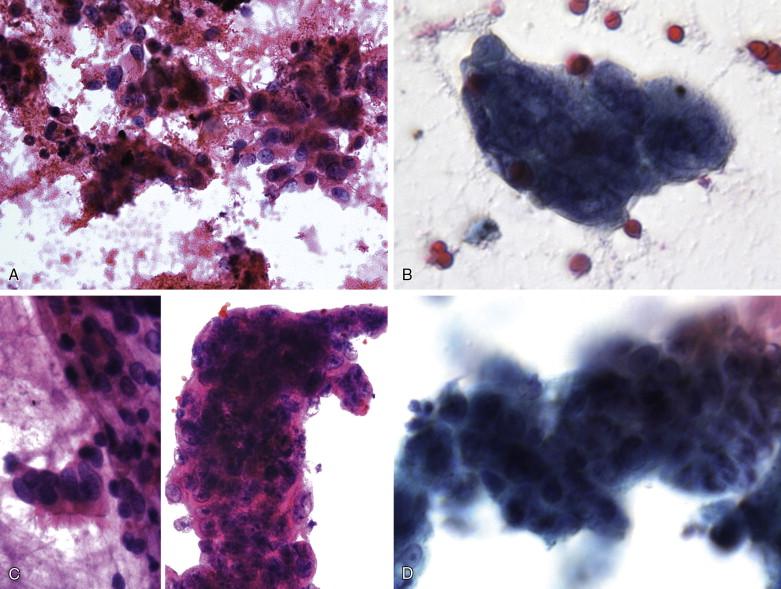
The presence of a pathologist or a cytotechnologist on site can be very helpful to assess specimen adequacy, identify cases in which additional samples need to be obtained, and quickly diagnose the presence of metastatic NSCLC using smears and touch preparations. It can also help optimize the preservation of cellular samples sufficient for the preparation of cell blocks needed for ancillary studies such as immunocytochemistry, electron microscopy, or molecular analysis. A recent large multicenter study of five hospitals in the United Kingdom demonstrated that cytology samples obtained by EBUS-TBNA were suitable for subtyping NSCLC using immunohistochemistry and for epidermal growth factor receptor (EGFR) mutation analysis (Navani et al, 2012).
Wedge biopsies of the lung can be very useful in evaluating patients with acute respiratory insufficiency and determining the etiology of pulmonary infiltrates in the lung and other allograft recipients, adult respiratory distress syndrome (ARDS or acute interstitial pneumonia, AIP), immunodeficiency such as acquired immunodeficiency syndrome (AIDS), pulmonary hemorrhage syndrome, and other conditions (Sienko et al, 2005). Wedge biopsies of the lung are being performed more frequently at our institution as a result of the availability of VATS procedures associated with considerably lower morbidity than thoracotomy. The approach listed in Table 9-2 is suggested for the intraoperative diagnosis and handling of these biopsies:
The pathologist should obtain the clinical history prior to performing frozen sections from patients with nonneoplastic acute or chronic lung conditions.
| Patient has an acute nonneoplastic condition |
|
| Patient has chronic diffuse lung disease |
|
| Patient has ground-glass opacity |
|
| Patient has lung mass |
|
Thoracic surgeons are usually busy and mostly concerned with obtaining adequate tissue during VATS, and they tend to provide pathologists with only limited clinical information at the time of intraoperative consultation (IOC). However, this does not relieve the pathologist’s responsibility of reviewing the patient’s electronic medical records and/or phoning the patient’s pulmonologist to fully understand the indications for the biopsy so that the lung or other tissues are properly preserved in a manner that allows the performance of all necessary tests. Unfortunately, it has been our experience with our own cases or with cases operated at other institutions and received in consultation that pathologists occasionally forget to follow this routine, resulting in incomplete workup of wedge lung biopsies because someone forgot to save tissues for culture, immunofluorescence, and/or electron microscopy.
Does the frozen section show pathologic changes that would help treat the patient immediately?
Most frozen sections from patients with acute lung injury show somewhat generic changes of diffuse alveolar damage such as hyaline membranes and early intraalveolar fibrosis that offer limited information to help initiate therapy until cultures and other studies are performed ( Figure 9-11 ). However, some frozen sections show the presence of pathologic changes that can help expedite therapy. Findings such as the presence of acute alveolitis with numerous intraalveolar neutrophils suggestive of a bacterial pneumonia ( Figure 9-12 ), granulomatous inflammation, viral changes, fungal forms, pulmonary emboli, and/or lung infarction should be identified on frozen section and communicated to the appropriate physicians so that the patient can be treated appropriately as soon as possible. ( Figure 9-13 ).
Consider saving fresh lung tissues for culture and/or immunofluorescence and fixing tissues in glutaraldehyde for electron microscopy.
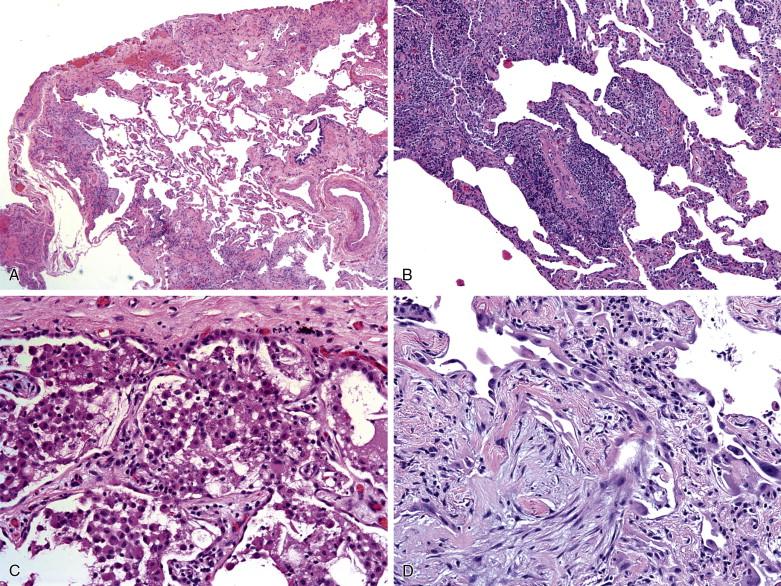
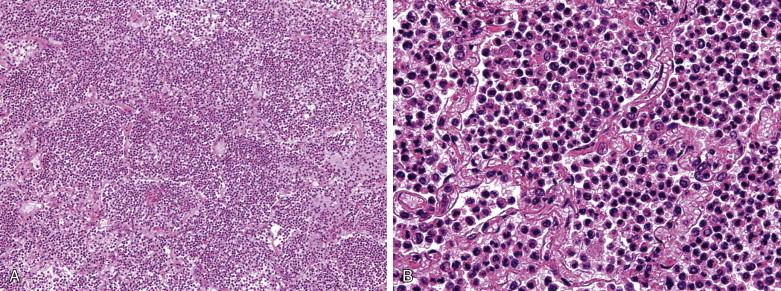
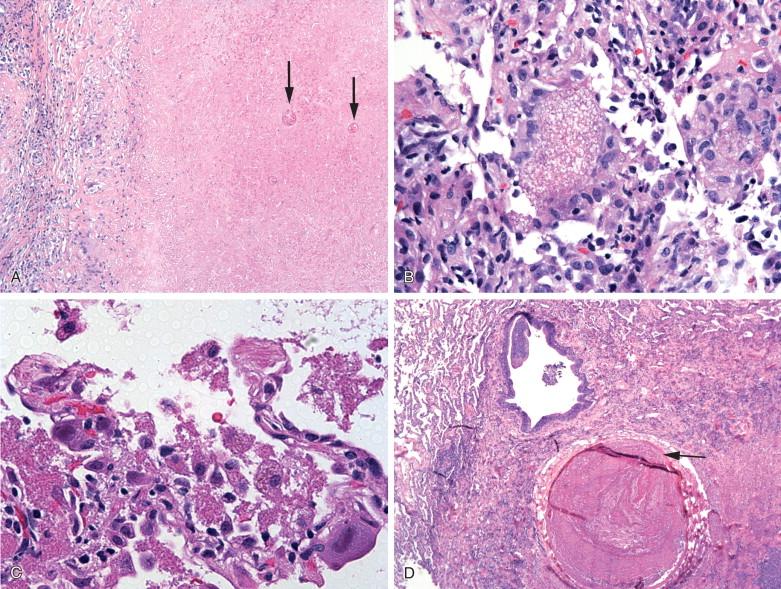
Histopathology is often inadequate to identify the etiology of acute lung injury, and fresh lung tissues need to be sent for bacterial, fungal, and viral cultures. In patients with a history of connective tissue disorder or pulmonary hemorrhage syndrome, portions of lung tissues should be placed in transport medium and sent for immunofluorescence studies (Sienko et al, 2005). Occasionally, other portions of lung tissues need to be fixed in glutaraldehyde in patients where a particular viral condition is suspected.
How can the diagnosis be expedited? Can the laboratory process tissues the same day? What special stains need to be ordered?
It is important for pathologists performing frozen sections from patients with acute lung injury to do their best to expedite the final diagnosis by inquiring whether the histology laboratory could process the lung tissues the same day and by ordering special stains (e.g., Gomori methenamine silver, Ziehl-Neelsen, mucicarmine, in situ hybridization for herpes virus, cytomegalovirus, or other stains suggested by the frozen section findings) immediately to avoid diagnostic delays. This task is particularly important when dealing with biopsies from transplant or immunosuppressed patients or with specimens received on Fridays or holidays when there is greater potential for diagnostic delays.
Wedge lung biopsies are also used for the diagnosis and classification of chronic diffuse lung diseases such as usual interstitial pneumonia (UIP), nonspecific interstitial pneumonia (NSIP), cryptogenic organizing pneumonia (COP), and other forms of idiopathic diffuse interstitial lung disease ( Figure 9-11 ) (Flaherty et al, 2007; Travis et al, 2008). In these patients the thoracic surgeon needs to biopsy different lobes, preferably by selecting areas from all lobes that are not very fibrotic on gross evaluation. Pathologists are not expected to provide a precise classification of the chronic interstitial lung disease on frozen section but to ensure that sufficient tissue for a diagnosis is available. Pathologists also need to check the clinical history for possible connective tissue disorder. In patients with these conditions, it is advisable to submit fresh tissues for immunofluorescence.
There is an increasing interest in the early detection of lung cancer by chest CT scans, resulting in the detection of localized ground-glass opacities (GGO) that precipitate lung biopsies performed to exclude the possibility of adenocarcinoma in situ (AIS) or microinvasive adenocarcinoma of the lung (Oh et al, 2007). Because these lesions are generally nonpalpable, thoracic surgeons use needle localization and other techniques to find them during VATS (Marchevsky et al, 2004; Gupta et al, 2008; Walts and Marchevsky, 2012a). AIS and microinvasive adenocarcinomas of the lung are often difficult to visualize grossly on lung wedge biopsies because they have the same consistency as normal lung tissue and appear as gray-black macules that are difficult to visualize because of congestion and the oozing of blood during gross inspection ( Figure 9-14 ). Pathologists should request that surgeons mark the suspicious area with a suture or other identifier to ensure that the lesion is adequately sampled at the time of frozen section (Walts and Marchevsky, 2012a). In instances when the first lung sample does not show a lesion that would correspond in size to the suspicious area visualized on CT scan, additional frozen sections from areas adjacent to those designated by the surgeon need to be sampled to avoid false-negative results.
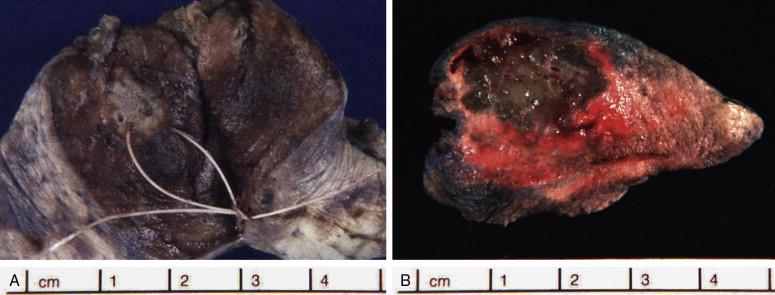
The diagnosis of pulmonary AIS by frozen section can be difficult (Marchevsky et al, 2004; Gupta et al, 2008; Walts and Marchevsky, 2012). The tumor needs to be distinguished from reactive pneumocyte hyperplasia associated with interstitial pneumonia and/organizing pneumonia and from peribronchiolar metaplasia with reactive atypia. AIS can usually be recognized at low power microscopy (x40 or x10) as well-circumscribed lesions, whereas interstitial pneumonias tend to be more diffuse and with less distinct boundaries ( Figure 9-15 ). The alveolar septa in typical cases of AIS are thin without significant inflammation or fibrosis, but they can exhibit some fibrosis and moderate to severe chronic inflammation, resulting in difficult diagnostic problems. The nuclei of the AIS tumor cells are usually visible at these low magnifications because these cells are larger than normal pneumocytes ( Figure 9-16A, B ). Both the tumor cells or AIS and reactive pneumocytes are distributed along alveolar septa in a lepidic growth pattern, but the neoplastic cells tend to stratify in focal areas into several cell layers ( Figure 9-16C ). High-power microscopy is helpful to recognize that the tumor cells of AIS usually have larger nuclei than normal pneumocytes type II and can exhibit hobnail features, high nucleocytoplasmic ratios, and intranuclear pseudoinclusions ( Figure 9-16D ).
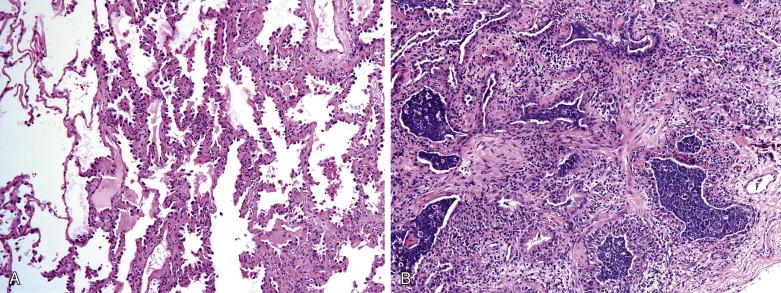
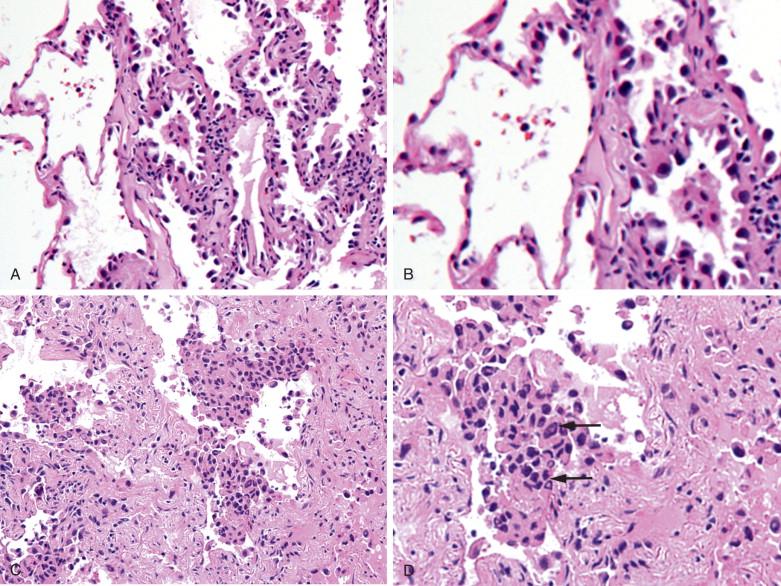
Peribronchiolar metaplasia exhibits a focal or multifocal distribution centered around bronchovascular bundles and exhibits epithelial cells that are ciliated ( Figure 9-17 ).
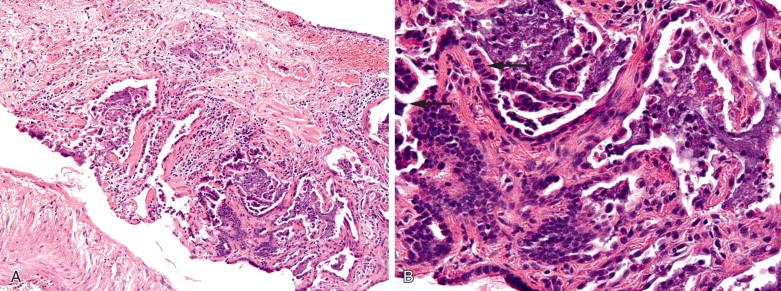
Unfortunately, none of these histopathologic features, other than the presence of ciliated epithelial cells, is pathognomonic of malignancy, and these various features need to be considered in aggregate. Figure 9-18 shows the relative value of various diagnostic features to distinguish reactive pneumocyte hyperplasia from adenocarcinoma (Gupta et al, 2008).
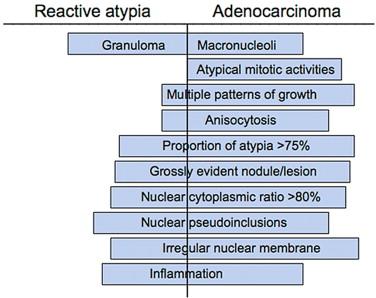
Once AIS is diagnosed by frozen section, the biopsy needs to be evaluated for the presence and extent of stromal invasion, characterized by the presence of single or groups of tumor cells within fibrotic alveoli, reactive fibrotic changes, and the presence of papillary or micropapillary features ( Figure 9-19 ). A simple rule that can be helpful in this differential diagnosis is to consider whether the tumor area resembles the morphology of the normal lung or not. Because AIS characteristically grows in a lepidic pattern without distorting the lung architecture, this consideration can be helpful to distinguish these lesions from invasive carcinomas that exhibit papillary or micropapillary growth features ( Figure 9-20 ).
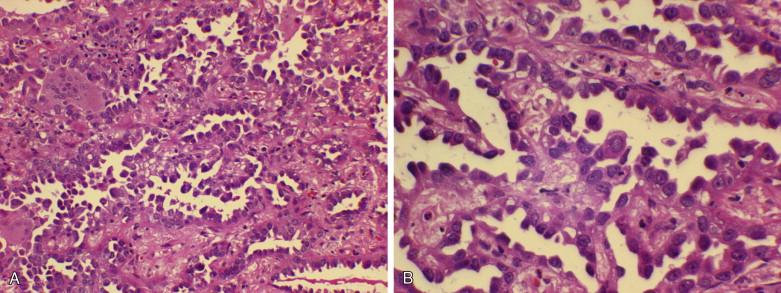
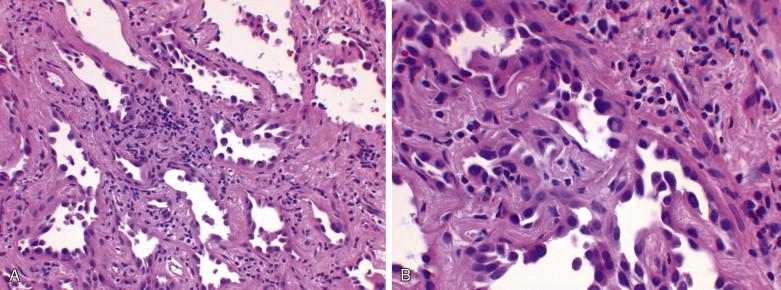
A large proportion of patients with lung neoplasms in our hospital present with peripheral lung mass lesions that are frequently diagnosed for the first time by frozen section (Marchevsky et al, 2004). These peripheral lesions are often difficult to diagnose with bronchoscopy, and although they can be reached with transthoracic fine needle aspiration (FNA) or needle core biopsies, these patients often undergo VATS wedge biopsy with frozen section providing the initial diagnosis of malignancy, followed in the same operation by a lobectomy or another definitive surgical procedure. The differential diagnosis for a pathologist performing a frozen section from a lung mass lesion includes a carcinoma, primary or metastatic, granulomatous pneumonia, organizing pneumonia, pulmonary hamartoma, and, less often, other neoplasms such as carcinoid tumor, malignant lymphoma, and sarcoma.
Become a Clinical Tree membership for Full access and enjoy Unlimited articles
If you are a member. Log in here